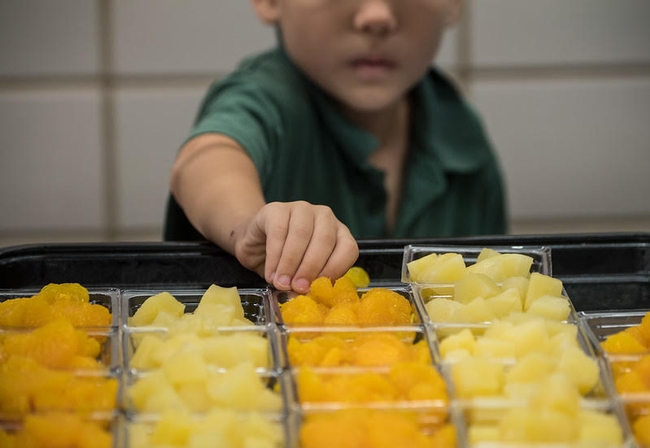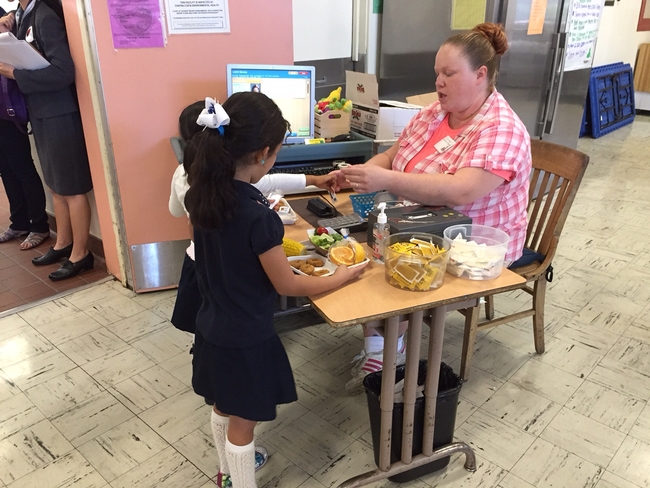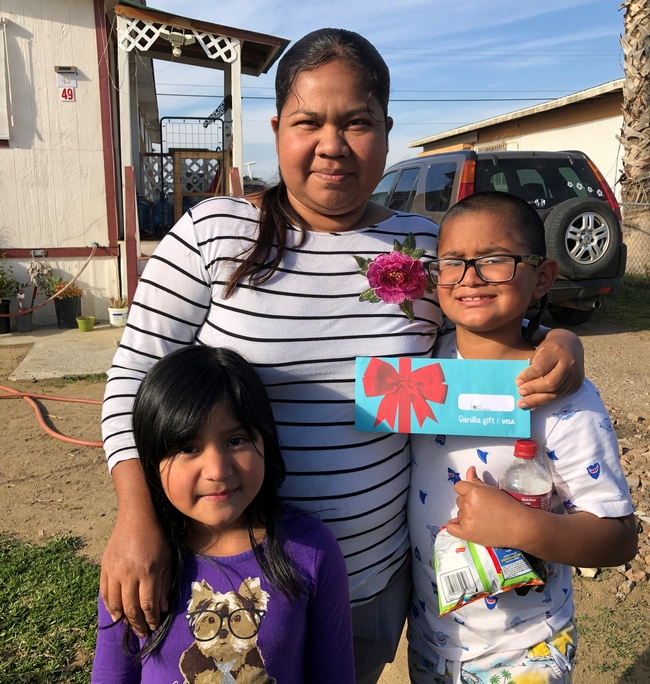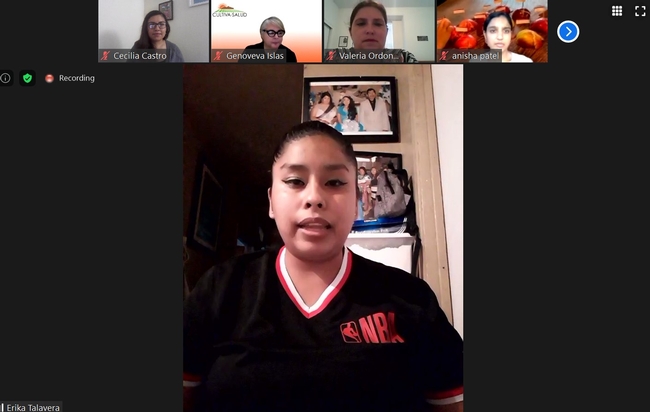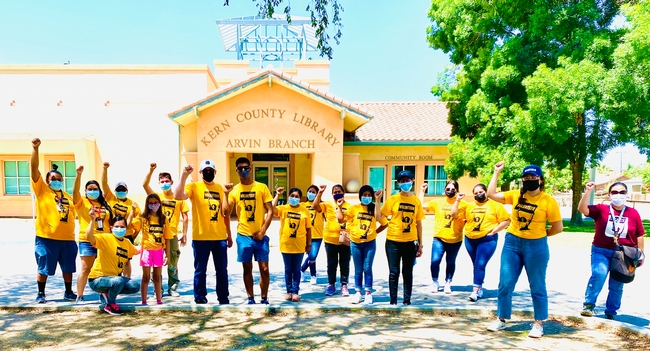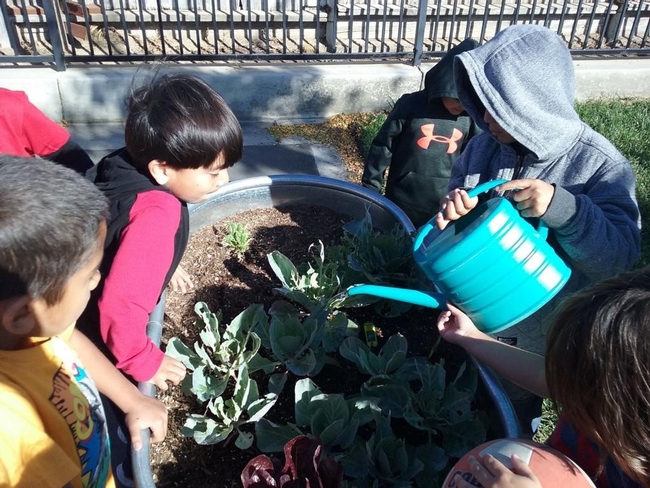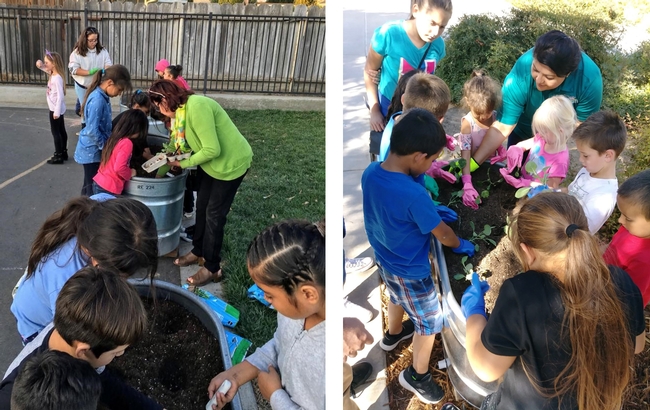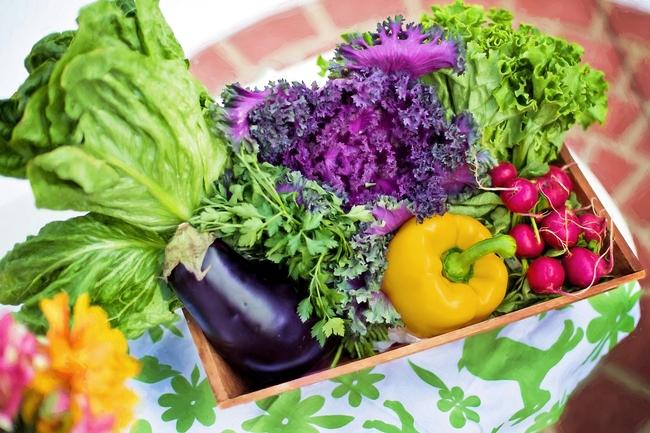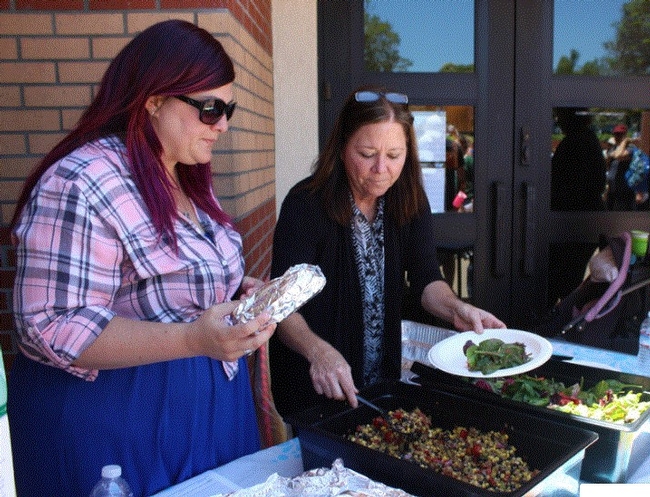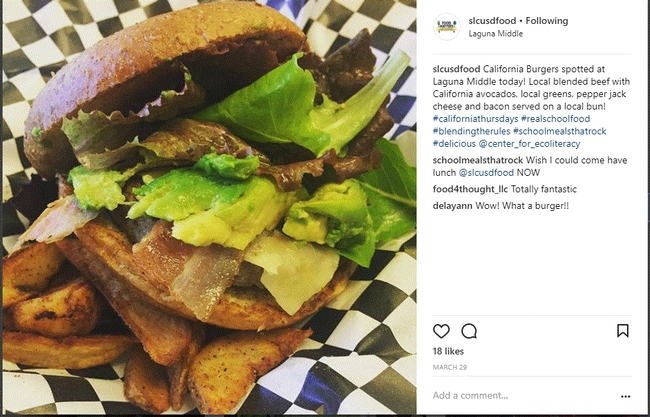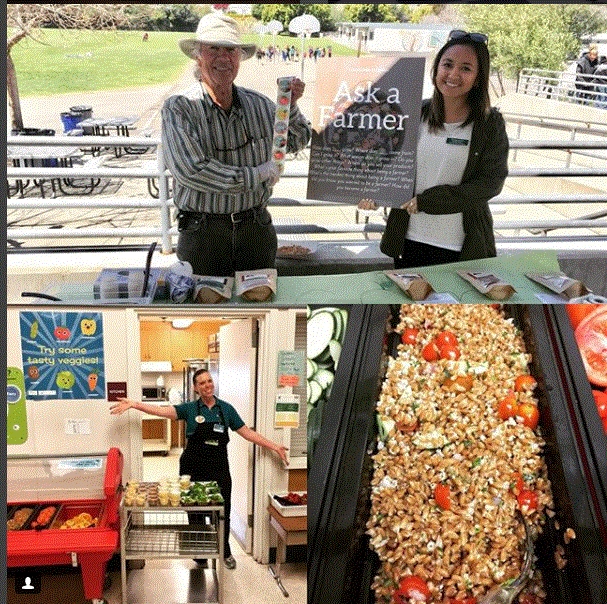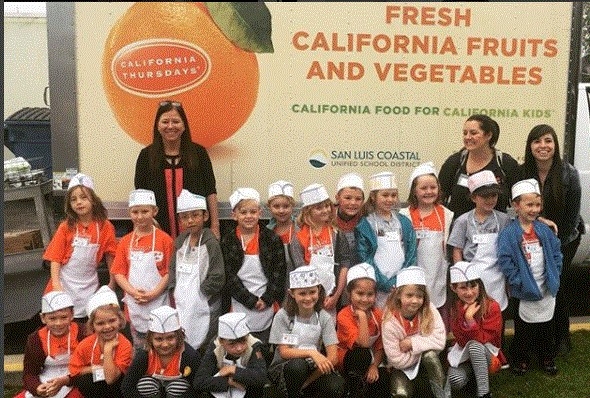Posts Tagged: school
Universal school meals increased student participation, lessened stigma
The COVID-19 pandemic exacerbated food and nutrition challenges. Many families initially lost access to meals offered by school and childcare facilities, experienced unemployment or work reductions, and faced increasing prices for food and other necessities. National and state policies and programs provided food and cash assistance to mitigate impacts on food security. Researchers at the Nutrition Policy Institute, a research center of University of California Agriculture and Natural Resources, evaluated safety-net policies implemented during the pandemic to better support families with low incomes in the U.S.
Benefits of universal school meals
The National School Lunch Program and the School Breakfast Program meet the nutritional needs of approximately 30 million K-12 students in America each day. Typically, students from families meeting income eligibility criteria receive school meals for free or a reduced price, while others pay full price.
NPI researchers Wendi Gosliner, project scientist, and Lorrene Ritchie, director and UC Cooperative Extension specialist, are co-leading studies of school meals in California in collaboration with researchers from the NOURISH Lab for Health Inclusion Research and Practice, who study school meals in Maine and other states.
During the COVID-19 pandemic, Congress funded school meals for all students at no charge, in order to address the dramatic increase in food insecurity among families with children after schools shut down in March 2020. This federal provision allowing for meals to be free for all students ended after the 2021-2022 school year, but some states elected to continue providing universal school meals with state funding, in recognition of the importance of these meals for student health and academic success.
California was the first state to adopt a statewide Universal Meals Program starting in the 2022-23 school year. To support the program's development, $650 million were invested to help schools improve kitchen infrastructure and provide staff training and technical assistance. Investments include Farm to School programs and other mechanisms to help update and improve school meals. Maine and several other states also have adopted universal school meals at least through the 2022-23 school year.
“States often act as incubators – things that work well in states sometimes get translated into federal policy,” Gosliner said. Identifying the success of the programs – and their challenges – can lead to improvements and help inform advocates and policymakers considering universal school meals policies at the state and national level.
Two of the team's research studies in California and Maine documented the benefits and challenges of universal school meals, as reported by school food authorities. Among 581 school food-service leaders in California who responded to the survey, nearly half (45.7%) reported reductions in student stigma as a result of providing free school meals to all students. Among 43 respondents in Maine, over half (51%) reported lessened stigma related to school meals being free for all. In both studies, nearly three-quarters of respondents reported increases in student meal participation. These and other data suggest that universal school meals are meeting their aim, to increase student participation while providing nutritionally balanced meals.
But when the child leaves campus, the responsibility to put a nutritious meal on the table falls on the caregiver.
“Universal school meals provide food and can ease families' budgets, but for too many families, wages as well as time and other resources are not adequate for access to and consumption of enough healthy foods and beverages,” Gosliner noted.
That is when other public programs are helpful, for example the Earned Income Tax Credit, or EITC.
Many eligible families do not claim Earned Income Tax Credit
The Earned Income Tax Credit is a national program designed to lift families out of poverty. The supplemental income can contribute up to nearly $7,000 per year for a family. Despite the EITC's known ability to improve participants' health, research shows that many EITC-eligible households in California and across the nation don't receive the benefits for which they are eligible, leaving $2 billion unclaimed in California in 2018 alone.
Gosliner led a study along with Lia Fernald from UC Berkeley and Rita Hamad from UC San Francisco to document levels of awareness, barriers to uptake, and benefits of participation in the EITC. Their recent publication reported that among 411 EITC-eligible California female caregivers, those who were younger, spoke languages other than English, and had less awareness of the EITC were less likely to receive the tax credit.
Developing a user-friendly system for providing safety-net support and, in the meantime, providing information and support to help more EITC-eligible families receive these benefits are suggested to help alleviate financial stressors. In the long term, these strategies may reduce poverty and improve the health of children.
Increasing WIC Cash Value Benefit a boon to health
In addition to universal school meals and EITC, families with low income may be eligible for the Special Supplemental Nutrition Assistance Program for Women, Infants and Children, or WIC. The program supports women and children up to 5 years old through nutrition education, nutritious foods and access to other health and social services.
One component of the WIC food packages, the Cash Value Benefit, provides participants a fixed dollar amount to supplement their family's diet with fruits and vegetables. During the pandemic, the U.S. Department of Agriculture increased this benefit from $9 to $35 per month, which was later revised to $24 per month per child in October 2021.
Ritchie contributed to a growing body of evidence on the importance and multidimensional benefits of the WIC Cash Value Benefit increase.
“Nine dollars buys only a quarter of what a child is recommended to eat every day,” Ritchie said. “The increase in Cash Value Benefit during the pandemic was an ideal natural experiment to investigate its impact.”
In collaboration with Shannon Whaley and her team at the Public Health Foundation Enterprises-WIC, NPI launched a longitudinal cohort study of nearly 2,000 California WIC participants. They found that the increased Cash Value Benefit improved WIC participant satisfaction with the program and allowed families to purchase greater quantities and varieties of fruits and vegetables.
“The increased Cash Value Benefit enabled WIC families to expose young children to new fruits and vegetables. Early exposure to a variety of fruits and vegetables is critical to establishing lifelong healthy habits,” said Ritchie.
The researchers found that the benefit increase also reduced food insecurity. It is hoped that the increase in program satisfaction translates into more eligible families enrolling and continuing to receive WIC. In November 2022, the U.S. Department of Agriculture proposed making the increased Cash Value Benefit a permanent part of WIC.
Knowing the proven benefits of the WIC program, Ritchie and colleagues from the National WIC Association, and Loan Kim at Pepperdine University, also engaged with WIC participants in other states.
In 2021, all state WIC agencies were invited to participate in a WIC satisfaction survey. Of the 12 WIC state agencies that opted to participate, Connecticut, Inter Tribal Council of Arizona, Nevada, New Hampshire and New Mexico added questions on the survey to understand how the increased Cash Value Benefit impacted children's dietary intake.
The study showed consumption of fruits and vegetables by children on WIC increased by one-third cup per day on average, which is sizable when considering the impact across the WIC population.
NPI research on universal school meals, the EITC and WIC constitute a small part of a more comprehensive approach to make healthy food more accessible, affordable, equitable and sustainable for all. The NPI provides resources such as policy briefs, peer-reviewed publications and technical assistance on several research areas such as safe drinking water, childcare and education. To learn more, please visit the Nutrition Policy Institute website.
No break for kids’ hunger: Partnerships help secure school meal programs
Partnering for California
As the gravity of the COVID-19 pandemic hit communities across the U.S. in mid-March 2020, the policy team at UC Agriculture and Natural Resources' Nutrition Policy Institute received an urgent email from a longtime partner in the San Joaquin Valley.
“It was simply entitled 'Help' in the subject line – with multiple exclamation points,” said Christina Hecht, NPI senior policy advisor.
The colleague was writing on behalf of community groups concerned that pandemic-related school closures would jeopardize school meal programs – a nutritional lifeline for children in a predominantly agricultural region with many low-income households.
Hecht immediately contacted a frequent collaborator, Anisha Patel, an associate professor of pediatrics at Stanford University. To help school districts continue those essential meals during the fast-approaching spring holiday, they quickly produced a fact sheet, “Kids' Hunger Doesn't Take a Spring Break,” sharing resources on how districts could use new program flexibility to continue meal distribution.
Then, as the pandemic evolved throughout 2020, the U.S. Department of Agriculture and California Department of Education continued to issue a flurry of waivers and guidance updates. To keep pace, the authors produced three more fact sheets to help districts digest the information and adapt and sustain their school meal programs.
“We tried to make a really user-friendly resource that would help districts sort through everything they needed to do, and easily discover resources for best practices,” Hecht said.
The fact sheet information, paired with advocacy by local partners, encouraged districts to take steps to make more meals more easily accessible to students by taking advantage of USDA waivers: for example, allowing parents to pick up meals without children present, providing multiple meals in one pick-up or implementing bus delivery of meals.
These efforts attracted the attention of the School Nutrition Association, a prominent nonprofit representing more than 50,000 members who provide meals to students across the country. The organization co-branded general versions of the fact sheets and distributed them widely through its website.
Gathering community perspectives on school meals
Those resources represent just one way that lessons from the San Joaquin Valley experience are shaping the national conversation on school nutrition programs. Cultiva La Salud and Dolores Huerta Foundation – health equity and social justice organizations based in Fresno and Bakersfield, respectively – approached the researchers to study ways to boost participation in school meal programs and address food insecurity in their largely Latino communities.
“Working alongside Stanford and NPI is crucial in expanding our capacity and ability to use data and research as a tool to empower parents to advocate for improved health and wellness policies and practices,” said Cecilia Castro, deputy director of Dolores Huerta Foundation, which works in Kern, Fresno and Tulare counties, as well as Antelope Valley in Los Angeles County.
To better understand the “barriers and facilitators” to meal program participation, Hecht, Patel and their collaborators – including student trainees who were eager to learn about community-based participatory research and wanted to help their local communities – sought the perspectives of school district administrators and staff, community groups and parents.
Through the relationships nurtured by Cultiva La Salud and Dolores Huerta Foundation, the researchers convened focus groups of parents with children in six school districts across the San Joaquin Valley.
“We needed to understand better what helped and hindered families from getting the school meals,” Hecht said.
According to Castro, parents have leveraged their feedback to advocate for increased access to school meals, through the use of buses for meal delivery and changes to meal pickup times and locations.
“This engagement has validated the lived experience of our communities,” Castro said. “It has provided an additional strategy for parent leaders to use in efforts to engage decision-makers about ways to improve quality and access to school meals.”
Another key takeaway from these conversations is that the parents are deeply concerned about the content and nutritive value of the meals served to their children.
“We learned that although school meals meet nutrition standards, parents are not aware of this,” Patel said. “Parents also worry about the healthfulness of school meals, noting heavy processing and added sugar. Most compelling was that parents want to provide feedback to improve school meal appeal and healthfulness but have no way to act.”
San Joaquin Valley voices go national
The Nutrition Policy Institute played a crucial role in bringing the parents' perspectives to legislative staff members at the state and federal levels, through the production of four policy briefs that center the voices of San Joaquin Valley residents. In the first, “School Meals: Kids Are Sweeter with Less Sugar,” one parent says: “Children cannot sustain themselves on treats that give pure sugar…They give with the best intentions, but less food would be better, but better quality and healthier.”
“One of the most rewarding parts of all this work has been seeing how meaningful it has been for the parents in the San Joaquin Valley to see their voices getting carried all the way to Washington, D.C. by these policy briefs,” said Hecht. “And it was so meaningful for them that Cultiva La Salud had the briefs translated into Spanish so that the parents could actually read their own words.”
Their voices joined a chorus comprising over 200 organizations who called for universal school meals across California. In June, the state became the first in the nation to adopt a policy, starting in the 2022-2023 school year, to provide free meals for all K through 12 public school students, regardless of family income. Momentum continues to build on the national scale.
The next step for the team is to explore ways to make school meals even more appealing to potential program participants in the Latino communities of San Joaquin Valley. Patel said they will draw on the expertise of Szu-chi Huang, associate professor of marketing in Stanford's Graduate School of Business.
“Using a participatory approach, we will work with parents and school officials to design an intervention focused on communicating the benefits of school meals, and test strategies to improve the appeal of school meals,” Patel explained. “Then we will examine how that intervention affects parents' satisfaction with school meals, students' participation in meals and food insecurity.”
Those insights will be another valuable result of a unique partnership – spurred by a call for help and galvanized by the ongoing health crisis – that continues to benefit families across California.
“Our partnership has been very unusual and very fruitful because we had policy experts, we had research experts and trainees, and then we had the organizations actually working in the community,” Hecht said. “And as we look back on it, it's hard to imagine working that successfully without that kind of partnership.”
CalFresh Healthy Living, UCCE educators and promotoras teach children gardening to encourage healthy eating
When local promotoras - volunteer health workers - team with CalFresh Healthy Living, UC Cooperative Extension educators, magic happens in school gardens. Trained by Ceres Partnership for Healthy Families in Stanislaus County, promotoras encourage children to eat well by growing their own produce in school gardens.
In 2018, twenty promotoras were trained to implement the Powerful People curriculum designed to engage community leaders. This is a partnership with Cultiva La Salud and Ceres Partnership for Healthy Families with funding support from Stanislaus County Health Services Agency. After the training, the promotoras worked with Ceres Unified School District to create school gardens at five Ceres elementary schools where their children attended afterschool programs that host UC Cooperative Extension CalFresh Healthy Living, UC programs.
A key initiative CalFresh, Healthy Living, UC (CFHL) offers in counties throughout the state involves growing fresh produce and making it a regular part of family diets. TWIGS: Youth Gardening and Healthy Eating Curriculum is a UC Agriculture and Natural Resources comprehensive curriculum with 16 garden lessons and 15 nutrition lessons available for free download from its website.
CFHL has teamed with promotoras in Stanislaus County since 2018 to ignite local participation in teaching children that participate in garden clubs about plant and nutrition science, from building soil to creating sumptuous salads. Two years ago, a new UCCE community education specialist was assigned to the project, Rosalinda Ruiz. A native Spanish speaker and a mother herself, Ruiz quickly developed close relationships with the promotoras.
“She's not just their teacher. They look to her as a mentor and a friend,” said Jaci Westbrook, CalFresh Healthy Living, UC Community Education Supervisor for Stanislaus and Merced counties.
Ruiz is also a certified UC Master Gardener, having completed rigorous coursework in sustainable food gardening, pest management, irrigation practices and soil health. She realized the TWIGS curriculum would reach more students if she taught the promotoras how to implement the lessons at school sites.
“This empowered the promotoras to gain knowledge and gave them a different purpose,” Westbrook said. “They don't need to rely on others to offer activities. Working in pairs or small groups, they are reaching 100 to 135 elementary school students themselves.”
Ruiz marvels at the many benefits of food gardening.
“Learning about gardening is the best thing families can do to teach their kids about healthy foods,” Ruiz said. “To grow your own food is a way to get fresh, nutritious food in your home. When kids see the fruit and vegetables growing and they're part of it, they are more willing to try it out.”
During the COVID-19 pandemic, promotoras instruction continued online using Zoom, which was completely new to them, and with WhatsApp, a familiar platform for promotoras to communicate among themselves.
The students are also getting virtual instruction. Promotoras have become proficient at Zoom and are offering simple garden lessons. Socially distanced in-person gardening lessons are also resuming to give children hands-on experience growing their own food.
Grow it: Gardening tips and resources
Gardening is fun…and it's an important activity. What we grow in school, home and community gardens can improve our health, and the health of our families and communities. What we grow can increase the resiliency of food systems in our communities. And what we grow, ultimately, can connect us more closely with the earth that sustains us. There are valuable lessons in gardening…too many to list here.
Even if you live in a small apartment, you can grow food. If you have a yard, you can grow quite a lot of food. View the transformation of a front yard in an urban area…from lawn to lush, productive food garden in only 60 days. You'll love the progression photos, and the simple explanation about how the garden came together.
Need more inspiration? Roger Doiron, founder of SeedMoney, talks about his (subversive) garden plot in this remarkable TedX talk. Roger created and led the social media campaign that called for a garden at the White House. This campaign ultimately led First Lady Michelle Obama to plant a vegetable garden at the White House. (And it may have also inspired the People's Garden at the USDA, which broke ground on Abraham Lincoln's birthday 10 years ago. Lincoln referred to the USDA as the “People's Department,” so it makes sense that the USDA would refer to its garden as the “People's Garden.”)
Need practical advice? The UC Master Gardener program has more than 5,000 certified volunteers ready to assist if you live in California. UC has also created a California Garden Web portal that provides a treasure trove of gardening resources for all parts of the state. It's not too early to begin planning your Fall garden, and you'll find information about that, too.
If you're interested in school gardens, read this brief history, written by UC ANR's UC Food Observer.
Happy gardening!
School food: Supporting healthy kids and local food systems
School food service is a multibillion dollar industry that impacts the lives of over 30 million (mostly) low-income students. Every school day and, with increasing frequency, during summer weekdays as well, this industry provides two-thirds of students' meals (breakfast and lunch), as well as snacks, contributing a large portion of the nutrients youth consume throughout their childhoods. To qualify for a free school lunch, a family of three must make less than $26,208 in 2016-17.
School food service directors have a huge charge on their hands: feed kids, every day, with a lot of requirements, for very little money. The current reimbursement rate for free meals provided to students in California is $3.31, which is required to include at least ½ cup of fruit or vegetables, and the choice to select a whole grain food, a protein food, and low-fat or non-fat milk. Elementary school kids from higher-income homes pay around $3 for the same meals.
So, when a canned mandarin from China is more economical than a local pixie tangerine, how does this impact food service directors' decisions to make sustainable and healthy food selections?
According to the San Luis Coastal Unified food service director, Erin Primer, food service directors have a lot of power to make healthy (or not so healthy) selections. Primer is a school food champion, who some have said is “murdering the lunch lady game.” Primer's first venture into institutional food service was in the private industry and catering. She learned how to get things done, how to be competitive and, ultimately, how to serve a lot of food that people want to eat.
Primer credits this background with enabling her to see things more creatively.
“Because of my background with catering, I was never limited by what school food says we can't do," Primer said. "I never let that burden me. When I came to school food, I loved the freedom to problem solve and connect all the dots with all the requirements, and then just feeding the kids.”
How do you feed kids healthy food while considering the broader impact of food purchasing decisions? Primer says it comes down to participation, it is a game of numbers. How many students and families will choose to eat a school meal on any given day? For Primer, that's about 3,000 lunches and 2,000 breakfasts every day - a number she would like to see grow.
What are some strategies to increase participation so more kids are eating school lunch? To Primer, and many food service directors that are rising to the challenge of feeding our next generation, it's about serving good food. It is easy to get stuck in the weeds of the regulatory environment of school food; and, while following the guidelines is incredibly important, it is also important to think about the food you are serving. Primer says she likes to think about the whole plate and what actually makes sense to serve to kids. You have to keep going back to asking yourself: “Will kids eat it?” and “Does it make sense?”
“We started with asking ourselves, does it taste good? Is it good quality? Is it sending the message we want to send? And if it's not, let's not do it, Primer said.
One of the biggest changes Primer has made to her menus is first, getting rid of the junk. In the world of school food, you can find chocolate doughnuts and cinnamon-sugar cereals that meet USDA regulations for the school meal program. In many cases, food processing companies have reformulated popular food items specifically to meet requirements. By adding in whole grains, or reducing the sugar, fat or sodium content in a product, they can be sold at school even if you could never find that same version of the product in the store. When students see these products at school it can send them mixed messages about what should be included as a regular part of a healthy diet.
The next change she made and continues to make includes increasing the purchase of local foods and removing items that can't be obtained locally. She is able to serve local, grass fed beef on the menu in a “blended burger” which includes mushrooms to make it larger, tastier and economically feasible. She also became one of the first school food service directors to use local grains by featuring emmer farro from a farmer that is less than 15 miles from her office. In addition, she has made some waves by replacing bananas on her menu with other local fruits, like kiwi.
Living on the central coast of California, there is an abundance of local foods available most months of the year. However, “local” does not need to be barrier for food service directors. Defining what is “local” or “regional” is up to each district or institution, who should take into consideration the surrounding agricultural landscape, seasons, and what foods are reliably available.
The last, but really important, step that Primer is working on is telling her story. Working with partners in creative ways, Primer is working hard to sell school food to all families in her district, regardless of their incomes. Her goal is to make meals that all kids want to eat and parents want to buy. She has her delivery trucks wrapped in pictures promoting the local foods they serve each day and she talks to local stakeholders, teachers, parents and school board members at every opportunity.
What are we feeding our kids? Where did it come from? How do our purchasing decisions impact our world?
These are the questions being tackled by school and institutional food service directors every day, whether they are aware of it or not. How they choose to answer those questions will have broad reaching impacts on our communities and future generations.


